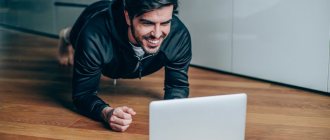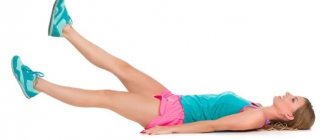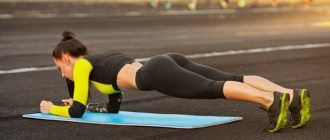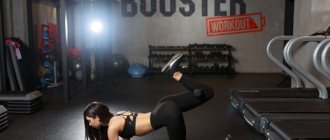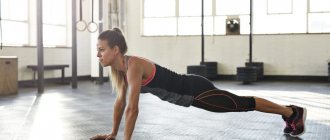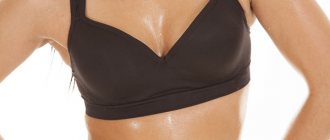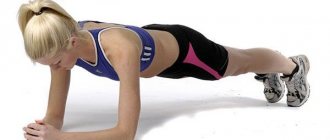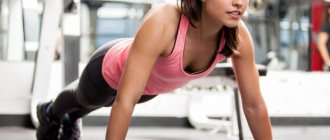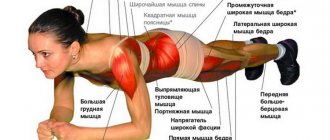The plank is a static exercise on the floor with emphasis on the hands or forearms. The plank is considered one of the most effective ways to remove the belly and tighten the entire body.
Let's figure out what the benefits, advantages and harms of planking are, how to do it correctly and how often, and whether planking is effective for weight loss. In addition, you will find in the article a unique selection of 100 variations of plank exercises.
What is the bar for?
The main purpose of the plank is to strengthen the core muscles. The core is a group of muscles in the abdomen, back, buttocks, and thighs that provide support for our limbs. Our arms and legs are only as strong as our core can provide them with. If there were no support for the core, our spine would gradually collapse.
The core is not six-pack abs. It has little to do with thinness or the visual image of our body in general. But it is he who makes the body strong.
The plank helps engage your core and pump up your brain. This is an exercise for the nervous system. During the plank, we train the brain's ability to control muscles. We learn to control body segments and create stability during loads on the arms and legs.
The plank cannot be the main exercise. But this is excellent preparation for running, jumping, and push-ups. The position of correct posture that we maintain in the plank can then be transferred to all movements in sports and life.
Training program
The main mistakes when doing the plank: relaxed abdominal muscles, buttocks and legs, sagging lower back and uneven weight distribution, bent knees, head raised up.
Typically, beginners cannot hold this position for more than 20-30 seconds. This is normal for an untrained person. But to achieve visible results, this time needs to be increased to 5 minutes, no less.
Perform the exercise 2-3 times every day, allowing yourself rest no more than once a week. In this case, every day the time for performing the plank should be increased by 10 seconds. If you can’t do it by 10, increase it by at least 5. Thus, in just a month you can get closer to the cherished 5 minutes and record the first results in losing weight.
There are superset schemes consisting of various variations of this exercise. They allow you to work out the maximum number of muscles in 10-15 minutes.
However, you should not set yourself the goal of quickly increasing the time it takes to complete the exercise. It is better to concentrate on technique and correct body position. It is advisable to conduct the first training in front of a mirror in order to independently control the correct position of the torso, arms and legs.
Many experts recommend focusing not on time, but on sensations. The appearance of a strong burning sensation in the abdomen is a signal that you should stop doing the plank. It’s better to do another approach after some time than to chase a certain number of minutes and seconds.
The first week of training will be the hardest. Muscles that are unaccustomed to such loads will ache. You can relieve pain with massage and hot baths. However, by the end of the week the body will get used to the stress and the discomfort will disappear.
How to stand in a plank correctly?
How to do the plank exercise correctly for weight loss? It is best to first build the correct plank while standing. TRX loops are great for helping you build a smooth progression and move from standing to plank. But even without loops, you can start on your own in front of the mirror.
- Stand with your feet parallel to each other. Support on three points: the base of the little finger, the base of the big toe, the heel. Press yourself lightly into the floor, as if you were standing on a piece of paper and trying to tear it with your feet.
- Find a neutral pelvic position. Imagine that the basin is a bowl of water. You need to fix it so that water does not spill out of the bowl. To fix the pelvis, you need to tense your buttocks. They will help relieve stress from the lower back. The front of your thighs should also be tense.
- Inhale and as you exhale, tighten your ribs so they don’t stick out. The abdominal muscles should be firm and the stomach should be flat.
- Keep your back neutral with a slight natural arch in your lower back. The shoulder blades are retracted and lowered.
- Bend your arms in front of you as if you were standing on your forearms. The forearms should be parallel to each other, like two straight lines.
- Keep your neck line straight. Tuck your chin in slightly to make your neck longer.
- The next step is to move this position to a horizontal position. If you can’t do this without discomfort in the neck and lower back, put the plank aside and do simpler preparatory exercises.
What effect does the exercise have?
Quick weight loss is not something worth doing a plank for: weight loss with its help is not as obvious as from an hour-long aerobic workout. This exercise primarily strengthens muscles and does not replace cardinal loads. Even photos in women’s reviews prove that the stand is only effective for improving shape, because it:
- makes the stomach flat;
- helps slim thighs;
- increases the elasticity of the buttocks;
- tightens the contours of the arms;
- strengthens the back.
Plank Exercise: 5 Key Positions
Choose the type of plank that you can perform perfectly and feel comfortable. Add load in small steps so as not to harm yourself. If a regular plank is difficult for you, start with a variation that relies on your knees and forearms. If the load, on the contrary, is too easy for you, you can try to complicate the exercise. Remember, the plank must be performed in combination with other exercises.
Forearm plank
The muscles of the hips and buttocks, all the muscles around the waist, including the abdominal muscles, the muscles of the shoulder blades and upper back, the pectoralis minor muscles and the serratus anterior muscles of the chest should be included in the work.
Place your socks on the floor and make sure they are approximately hip-width apart. The feet should be parallel to each other. Place your elbows directly under your shoulder joints, and place your palms at the same distance so that your forearms are parallel. Stretch your heels back, tighten the front of your thighs and buttocks.
Push yourself slightly off the floor, pulling your chest and neck forward a little. Then tighten your stomach and lift your body off the floor. Your body should be straight: ears, shoulder and hip joints should be in one line.
Straight arm plank
Not much harder than a forearm plank. Your hands should be slightly narrower than in the push-up position. Fingers point forward and elbows point back. It's as if you are closing the space with your armpits and slightly screwing your elbows into the floor.
It is better to get into this position from a position on all fours. When you have aligned your body in an even line, you can move your legs back one by one, tighten your buttocks and thighs and build a plank. Breathe evenly.
Three-point plank
A challenging variation that can be performed from a forearm-supported plank position or a palm-supported plank position. You can lift both your arms and legs off the floor.
Variation for hands
Place your right hand on your left shoulder and hold this position for 10 seconds. For the next 10 seconds, do the same with your other hand. Neither the hips, nor the chest, nor the head, nor the neck should move during movement. The body should be in an even line. The hips and shoulder blades should not sag, and the buttocks should be tense. It is better to keep your feet shoulder-width apart or even a little wider.
Variation for legs
Raise your leg slightly above the floor - about 2 centimeters. You should not raise your leg high, because this can cause overload of the lower back. Perform 10 seconds on one leg and 10 seconds on the other.
Options with three-point support load the muscles that are responsible for body rotation. In addition, you put additional stress on your arms and legs.
Side plank
Helps improve lower back function. Trains all the muscles that provide lateral control of the body. For runners, this is a must-have exercise.
You can exit the forearm plank by simply turning sideways toward the floor and rising onto your elbow. The pelvis turns sideways to the floor. The leg that is closest to the floor is placed behind, the second leg is slightly in front.
It is better to lean on your forearms rather than your hands. Make sure your glutes are engaged. You can lean on your bent leg. And in a more complex version - lean on two straightened legs. The most difficult option is a side plank with support on the forearm and one leg.
Benefits and effectiveness of the plank
The plank is a high-quality functional exercise for the muscles of the whole body. By regularly performing static core exercises, you will not only tighten your muscles and improve your body quality, but also get rid of back problems. But this can only be achieved with the correct execution technique.
Benefits of doing planks:
- The plank is an ideal abdominal exercise because it targets all major abdominal muscle groups, including the transversus, rectus, and obliques.
- The plank engages not only the abdominal muscles, but also the muscles of the entire core, shoulders, chest, buttocks, upper back, front and back of the thigh. This is a unique exercise that will force your entire body to work.
- Thanks to the bar, you will strengthen the muscle corset that supports your spine, which is an excellent prevention of back pain. However, if you already have back problems, the plank can be performed only after consulting a doctor.
- With the help of a plank, you will strengthen your back and buttocks without damaging the musculoskeletal system and joints.
- Doing planks regularly will help you maintain a straight posture and a straight back.
- The plank exercise is suitable for everyone, from beginner to advanced. Simply adjust the time you hold the static position depending on your training.
- By strengthening your core muscles, you can improve your balance and poise, which will benefit you in everyday life.
- Unlike many other abdominal exercises, the plank does not have a damaging effect on your lower back (only with the right technique).
- The plank has a large number of modifications. For example, our article offers more than 100 options!
- You can do the plank absolutely anywhere: at home, on the street, in the gym. You just need some free space.
However, despite all the benefits of the plank, this exercise can be fraught with danger.
Harm of the bar:
- If your core muscles are not strong enough, your spine will sag during the plank, putting pressure on your spinal discs, lower back, and shoulder joints. With the slightest violation of the correct form of the exercise, you may feel pain in the neck or lower back.
- Prolonged planking can cause high blood pressure and even a heart attack, and people with hypertension are especially at risk. Therefore, you should not be in the plank for more than two minutes at a time. If you want to increase the load on the muscles, then it is better to go in the direction of complicating the plank options than in the direction of increasing the time of the static position.
- For people who are overweight, it is recommended to do the plank on your knees. This will help reduce stress on your back and joints.
Is planking effective for weight loss?
The plank strengthens muscles, works the core, improves the tone of the hips, buttocks, arms and shoulders, but to burn fat and lose weight overall, you need to change your diet. The plank only indirectly helps to remove the belly and get rid of the sides. This exercise tones muscles, speeds up calorie consumption, improves body contour, so it is very useful for building a slim body.
It is important to emphasize that the process of losing weight depends more on nutrition than on exercise. Exercising helps you burn more calories and improves your body quality, but weight loss only occurs with food restrictions (calorie deficit). The plank and its modifications are a great way to strengthen the body, get rid of sagging and lack of exercise, but to lose weight, dietary restrictions are required.
We recommend watching:
- Ready-made menu for 1500 calories: plan for 7 days with KBZHU
- Ready-made menu for 1200 calories: plan for 7 days with KBZHU
If your goal is to lose weight, then it is better to focus on dynamic exercises, which help burn more calories than static exercises. Ideally, do regular interval cardio exercise. Moreover, cardio exercises can also be performed in the plank, thereby achieving two goals at once: burning calories and strengthening the abdominal muscles.
Ready-made collections of cardio workouts:
- Versatile Cardio Workout (Intermediate)
- Tabata training without jumping (intermediate level)
- Intense cardio workout 500 kcal for 8 rounds
Errors when doing planks
In order to avoid problems with the spine from performing the plank incorrectly, we draw your attention to typical mistakes in this exercise.
1. Lifting the pelvis up
2. Sagging in the lower back
3. Rounding the back in the thoracic region
4. Elbows not under shoulders
5. Raising the head, tension in the neck
6. Bend your legs, relax your knees
How long to plank to lose weight?
No matter how long you stand in the plank, this exercise will not help you lose weight. Moreover, if you stand for a long time, you increase the likelihood of harming yourself. You need to stand in the plank for as long as you can stand in it correctly. Remember that in this position you are training the nervous system to a certain muscle position. A sagging or twisted bar will cause your muscles to become accustomed to working incorrectly in everyday life.
Core muscle training specialist, Canadian scientist Stuart McGill points out that people who stand in the plank for a long time most often stand incorrectly. When a person stands in the plank for 30 seconds or longer, he concentrates on the correct technique for the first 10 seconds, and then loses this position.
How to stand in a plank correctly? Instead of 30 seconds, of which only 10 will be useful, it is better to do 3 sets of 10 seconds. This way you can do from 3 to 30 approaches of 10 seconds with rest breaks of 3-5 seconds. The positive effect will only increase.
You don't need to stand for a long time, you need to stand well. If the plank is very easy, there are many more complex variations: with support on three points, with touching the shoulder, with movement of the legs.
Does planking burn belly fat?
The bad news is that plank pose is one of the hardest exercises to add to your workout routine. But on the other hand, you will actively burn calories while performing this treacherous exercise. Planks fit perfectly into any training program, whether you work out in the gym or at home. In just a couple of seconds you will feel that the exercise is working. Below we will tell you whether you can lose weight by doing the exercise at home and how to do it correctly for maximum results.
Burning calories
Your body continuously burns calories at a slow pace regardless of your activity level. But during heavy exercises like planking, the rate of calorie burning increases. According to the FitClick website, a person weighing 68 kg will spend 221 kcal per hour of planking. Given that you are unlikely to plank for hours, you can calculate the number of calories burned over shorter periods. If you weigh 68kg, planking will help you burn three to four calories per minute.
Working muscles
Similar to all kinds of crunches, planks effectively load the abdominal muscles. Despite the narrow focus of this exercise, it requires the contraction of a number of other muscles while holding the position: the obliques, hip flexors, quadriceps, pectoral muscles, and many of the smaller leg muscles. Planks are a great workout for your core muscles.
Fat burning
Exercise is the main way to burn calories for weight loss. However, despite all the advantages of planks, they cannot be called the most effective exercises for getting rid of excess fat. To lose weight and lose a pound of fat, you will need to burn on average 3500 kcal more than you consume. Considering the relatively small amount of calories expended during planks, jogging or dancing will allow you to achieve better fat loss results.
Contraindications to performing the plank
If you are not able to build your body into a plank and feel comfortable, it is better to postpone it. If it seems to you that the bar is level, but you feel discomfort in your back or neck, you also need to hold off on this exercise.
Another factor is that it is important to maintain even, calm breathing while doing the plank. If shortness of breath begins, this is a sign that it is too early to start the plank.
If static loads are not recommended for you, then the bar is also not recommended. Such contraindications are possible for cardiovascular diseases, problems with blood pressure and vision.
Errors during execution
Experts say that the key problem for beginners is trying to take a more comfortable position for the back, when, out of habit, the load causes discomfort, which is expressed in lumbar deflection. This is a major mistake that not only reduces the effectiveness of the stance, slowing down the rate of weight loss, but can also cause subsequent problems with the spine. Excessive load on the lumbar region will negatively affect the position of the vertebrae, the distance between them, etc.
There are several other mistakes that have a negative impact on health:
- Rounding of the back (that's right - a perfectly straight body) is mainly observed in men. This is also explained by the desire to shift the emphasis of the load and short pectoral muscles.
- Tilt or lift of the head. It often comes from the fact that a person does not know how to hold his head correctly so as not to overstrain the neck muscles (which happens when bending or throwing back). The head in such a stance is a continuation of the body, looking down, the top of the head forward.
- Errors in the placement of the palms. This point applies to the classic plank, which should not be done on the elbows, although this statement can also be used for the latter. The support of the arms must be strictly under the shoulders so that the exercise affects the body (mainly the back) correctly.
